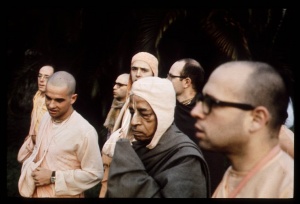CC Madhya 6.151 (1975): Difference between revisions
(Vanibot #0027: CCMirror - Mirror CC's 1996 edition to form a basis for 1975) |
(Vanibot #0020: VersionCompareLinker - added a link to the Version Compare feature) |
||
| Line 2: | Line 2: | ||
<div style="float:left">'''[[Sri Caitanya-caritamrta (1975)|Śrī Caitanya-caritāmṛta (1975)]] - [[CC Madhya (1975)|Madhya-līlā]] - [[CC Madhya 6 (1975)|Chapter 6: The Liberation of Sārvabhauma Bhaṭṭācārya]]'''</div> | <div style="float:left">'''[[Sri Caitanya-caritamrta (1975)|Śrī Caitanya-caritāmṛta (1975)]] - [[CC Madhya (1975)|Madhya-līlā]] - [[CC Madhya 6 (1975)|Chapter 6: The Liberation of Sārvabhauma Bhaṭṭācārya]]'''</div> | ||
<div style="float:right">[[File:Go-previous.png|link=CC Madhya 6.150 (1975)|Madhya-līlā 6.150]] '''[[CC Madhya 6.150 (1975)|Madhya-līlā 6.150]] - [[CC Madhya 6.152 (1975)|Madhya-līlā 6.152]]''' [[File:Go-next.png|link=CC Madhya 6.152 (1975)|Madhya-līlā 6.152]]</div> | <div style="float:right">[[File:Go-previous.png|link=CC Madhya 6.150 (1975)|Madhya-līlā 6.150]] '''[[CC Madhya 6.150 (1975)|Madhya-līlā 6.150]] - [[CC Madhya 6.152 (1975)|Madhya-līlā 6.152]]''' [[File:Go-next.png|link=CC Madhya 6.152 (1975)|Madhya-līlā 6.152]]</div> | ||
{{CompareVersions|CC|Madhya 6.151|CC 1975|CC 1996}} | |||
{{RandomImage}} | {{RandomImage}} | ||
==== TEXT 151 ==== | ==== TEXT 151 ==== | ||
<div class="verse"> | <div class="verse"> | ||
:ataeva śruti kahe, | :ataeva śruti kahe, brahma--saviśeṣa | ||
: | :'mukhya' chāḍi' 'lakṣaṇā'te māne nirviśeṣa | ||
</div> | </div> | ||
| Line 18: | Line 17: | ||
<div class="synonyms"> | <div class="synonyms"> | ||
ataeva—therefore; śruti—Vedic mantras; kahe—say; brahma—the Absolute Truth; sa-viśeṣa—personal; mukhya—direct meaning; | ataeva—therefore; śruti—Vedic mantras; kahe—say; brahma—the Absolute Truth; sa-viśeṣa—personal; mukhya—direct meaning; chāḍi'-giving up; lakṣaṇā'te—by interpretation; māne—accept; nirviśeṣa—impersonal. | ||
</div> | </div> | ||
| Line 25: | Line 24: | ||
<div class="translation"> | <div class="translation"> | ||
"All these mantras confirm that the Absolute Truth is personal, but the Māyāvādīs, throwing away the direct meaning, interpret the Absolute Truth as impersonal. | |||
</div> | </div> | ||
| Line 39: | Line 38: | ||
:tam āhur agryaṁ puruṣaṁ mahāntam | :tam āhur agryaṁ puruṣaṁ mahāntam | ||
This Vedic mantra clearly states, puruṣaṁ mahāntam. The word puruṣa means | This Vedic mantra clearly states, puruṣaṁ mahāntam. The word puruṣa means "person." That person is confirmed in the Bhagavad-gītā by Arjuna when he addresses Kṛṣṇa, puruṣaṁ śāśvatam: "You are the original person." ([[BG 10.12 (1972|Bg. 10.12]]) This puruṣaṁ mahāntam is Śrī Kṛṣṇa. His hands and legs are not mundane, but are completely transcendental. However, when He comes, fools take Him to be an ordinary person (avajānanti māṁ mūḍhā mānuṣīṁ tanum āśritam). One who has no Vedic knowledge, who has not studied the Vedas from a bona fide spiritual master, does not know Kṛṣṇa. Therefore he is a mūḍha. Such fools take Kṛṣṇa to be an ordinary person (paraṁ bhāvam ajānantaḥ). They do not actually know what Kṛṣṇa is. Manuṣyāṇāṁ sahasreṣu kaścid yatati siddhaye. It is not possible to understand Kṛṣṇa simply by studying the Vedas perfectly. One must have the mercy of a devotee (yat-pādam). Unless one is favored by a devotee, he cannot understand the Supreme Personality of Godhead. Arjuna confirms this in the Bhagavad-gītā ([[BG 10.14 (1972)|10.14]]): "My Lord, it is very difficult to understand Your personality." The less intelligent class of men cannot understand the Supreme Personality of Godhead without being favored by His devotee. Therefore the Bhagavad-gītā ([[BG 4.34 (1972)|4.34]]) contains another injunction: | ||
:tad viddhi praṇipātena paripraśnena sevayā | :tad viddhi praṇipātena | ||
:upadekṣyanti te jñānaṁ jñāninas tattva-darśinaḥ | :paripraśnena sevayā | ||
:upadekṣyanti te jñānaṁ | |||
:jñāninas tattva-darśinaḥ | |||
One has to approach a bona fide spiritual master and surrender to him. Only then can one understand the Supreme Personality of Godhead as a person. | One has to approach a bona fide spiritual master and surrender to him. Only then can one understand the Supreme Personality of Godhead as a person. | ||
Latest revision as of 18:35, 27 January 2020

A.C. Bhaktivedanta Swami Prabhupada
TEXT 151
- ataeva śruti kahe, brahma--saviśeṣa
- 'mukhya' chāḍi' 'lakṣaṇā'te māne nirviśeṣa
SYNONYMS
ataeva—therefore; śruti—Vedic mantras; kahe—say; brahma—the Absolute Truth; sa-viśeṣa—personal; mukhya—direct meaning; chāḍi'-giving up; lakṣaṇā'te—by interpretation; māne—accept; nirviśeṣa—impersonal.
TRANSLATION
"All these mantras confirm that the Absolute Truth is personal, but the Māyāvādīs, throwing away the direct meaning, interpret the Absolute Truth as impersonal.
PURPORT
As mentioned above, the Śvetāśvatara Upaniṣad (3.19) states:
- apāṇi-pādo javano grahītā
- paśyaty acakṣuḥ sa śṛṇoty akarṇaḥ
- sa vetti vedyaṁ na ca tasyāsti vettā
- tam āhur agryaṁ puruṣaṁ mahāntam
This Vedic mantra clearly states, puruṣaṁ mahāntam. The word puruṣa means "person." That person is confirmed in the Bhagavad-gītā by Arjuna when he addresses Kṛṣṇa, puruṣaṁ śāśvatam: "You are the original person." (Bg. 10.12) This puruṣaṁ mahāntam is Śrī Kṛṣṇa. His hands and legs are not mundane, but are completely transcendental. However, when He comes, fools take Him to be an ordinary person (avajānanti māṁ mūḍhā mānuṣīṁ tanum āśritam). One who has no Vedic knowledge, who has not studied the Vedas from a bona fide spiritual master, does not know Kṛṣṇa. Therefore he is a mūḍha. Such fools take Kṛṣṇa to be an ordinary person (paraṁ bhāvam ajānantaḥ). They do not actually know what Kṛṣṇa is. Manuṣyāṇāṁ sahasreṣu kaścid yatati siddhaye. It is not possible to understand Kṛṣṇa simply by studying the Vedas perfectly. One must have the mercy of a devotee (yat-pādam). Unless one is favored by a devotee, he cannot understand the Supreme Personality of Godhead. Arjuna confirms this in the Bhagavad-gītā (10.14): "My Lord, it is very difficult to understand Your personality." The less intelligent class of men cannot understand the Supreme Personality of Godhead without being favored by His devotee. Therefore the Bhagavad-gītā (4.34) contains another injunction:
- tad viddhi praṇipātena
- paripraśnena sevayā
- upadekṣyanti te jñānaṁ
- jñāninas tattva-darśinaḥ
One has to approach a bona fide spiritual master and surrender to him. Only then can one understand the Supreme Personality of Godhead as a person.